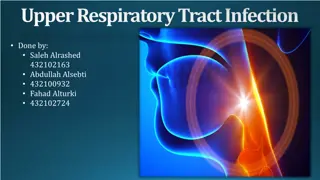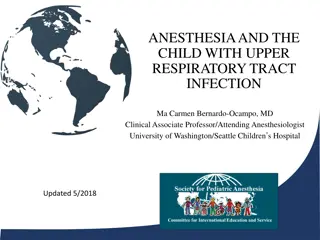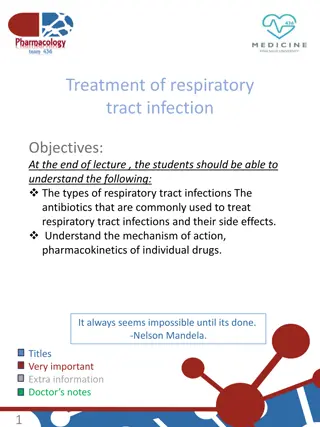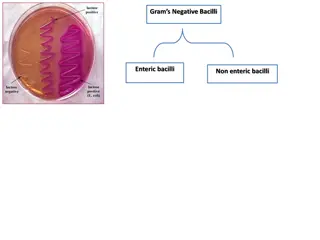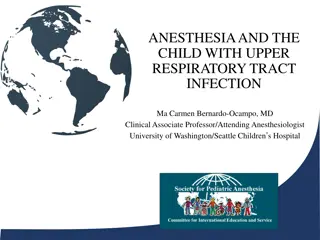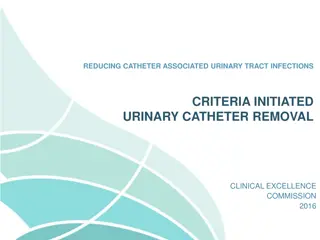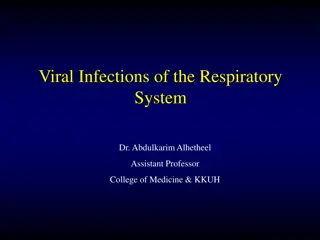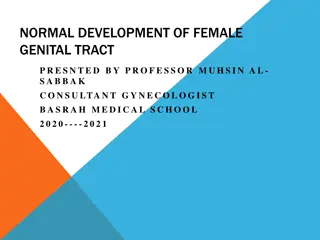Lower Genital Tract Infections
Lower genital tract infections refer to various inflammatory conditions affecting the vagina, cervix, vulva, and surrounding areas. These infections can be caused by bacteria, viruses, or fungi, leading to symptoms such as abnormal discharge, itching, and pain. Proper diagnosis and treatment are essential to managing lower genital tract infections and preventing complications.
Download Presentation

Please find below an Image/Link to download the presentation.
The content on the website is provided AS IS for your information and personal use only. It may not be sold, licensed, or shared on other websites without obtaining consent from the author.If you encounter any issues during the download, it is possible that the publisher has removed the file from their server.
You are allowed to download the files provided on this website for personal or commercial use, subject to the condition that they are used lawfully. All files are the property of their respective owners.
The content on the website is provided AS IS for your information and personal use only. It may not be sold, licensed, or shared on other websites without obtaining consent from the author.
E N D
Presentation Transcript
LOWER GENITAL TRACT INFECTIONS .
Vulvovaginal candidiasis This is one of the most common genital infections and is caused by Candida albicans in around 80 92 per cent of cases. Other non-albican species like C.tropicalis, C. glabrata, C. krusei and C. parapsilosis can also cause similar symptoms, although sometimes more severe and recurrent. C. albicans is a diploid fungus and is a common commensal in the gut flora.
Vaginal and cervical flora (all 1000 magnified). (a) Normal: lactobacilli seen as large Gram-positive rods predominate. Squamous epithelial cells are Gram negative with a large amount of cytoplasm.
Candidiasis: there are speckled Gram-positive spores and long pseudohyphae visible. There are numerous polymorphs present and the bacterial flora is abnormal, resembling bacterial vaginosis
Signs and symptoms Vulval itching and soreness, thick curdy vaginal discharge, dyspareunia and dysuria. Vulval oedema, vulval excoriation, redness and erythema. Normal vaginal pH.
Diagnosis It is important to confirm the diagnosis with a perineal and/or vaginal swab. Conditions such as contact dermatitis, allergic reactions and non- specific vaginal infections can present in a similar manner Predisposing factors Pregnancy high-dose combined oral contraceptive pill Immunosuppresion broad spectrum antibiotics diabetes mellitus hormone replacement therapy and HIV-infected women have a higher predisposition to
Treatment Up to 30 40 per cent of asymptomatic women may have C. albicans grown on a vaginal swab. These women do not need treatment even if they are pregnant. There is no evidence of any adverse effects in pregnancy to either the mother or the baby if treated with topical imidazoles. However, the oral imidazoles are contraindicated in pregnancy.
1.General and supportive care Women should be advised to avoid using any soaps, perfumes and synthetic underwear. The high-dose oestrogen combined oral contraceptive pill should be changed to a lower- dosepill. If there are persistent or recurrent symptoms, consideration should be given to change to a progesterone-only contraception. Check blood sugars to rule out undiagnosed diabetes mellitus and if present good glycaemic control should be the aim. Avoid recurrent courses of broad spectrum antibiotics.
2.Uncomplicated infection Azoles/imidazoles are the mainstay of the treatment. They can either be used either as a local topical application (pessaries/creams) or oral preparations The common imidazoles are clotrimazole, econazole and miconazole. Other antifungals, such as nystatin cream or pessary, can also be used. The medication can be taken as a single pessary treatment or a course of pessaries for a few days at a lower dose. The commonly prescribed medication is clotrimazole, which can be taken as single 500 mg pessary or a course of a 100 mg pessary over 6 days. Oral imidazoles, such as fluconazole, are given as a single dose at 150 mg or itraconazole 200 mg twice a day for 1 day. However, these are contraindicated in pregnancy. There is no evidence to treat the asymptomatic male partner..
3.Complicated infection Commonly seen in acute severe infection in pregnancy, women with diabetes mellitus or with immunosuppression conditions or therapy. The topical treatment in such cases can be extended to upto 2 weeks.
4.Recurrent infection Recurrent infection is defined as at least four episodes of infection per year and/or a positive microscopy of moderate to heavy growth of C. albicans. In such cases, the principle of treatment would be an induction regimen to treat the acute episode followed by a maintenance regimen to treat further recurrences. Commonly fluconazole 150 mg is given in three doses orally every 72 hours followed by a maintenance dose of 150 mg weekly for six months. There is a 90 per cent cure rate at six months and 40 per cent at one year with this regimen. Oral imidazoles cannot be used in pregnancy but a topical imidazole can be used for 2 weeks for induction followed by a weekly dose of clotrimazole 500 mg for possibly 6 8 weeks. There are no trials to indicate the duration of therapy in such cases.
Trichomonas vaginalis Trichomonas is a flagellate protozoan and can cause severe vulvovaginitis. It is usually sexually transmitted and commonly recurrences occur if the male partner is not simultaneously treated. It can also cause urinary tract infection. Signs and symptoms Vulval soreness and itching Foul smelling vaginal discharge, sometimes frothy yellowish green in nature. Dysuria and abdominal discomfort Asymptomatic carriers Appearances of strawberry cervix due to the presence of punctate haemorrhages.
Diagnosis Microscopy of vaginal discharge and culture in Finnberg Whittington or Diamond s medium. Wet mount, where the discharge is mixed with saline and examined under the microscope, may show the motile protozoal organism with the typical flagellae. This is sensitive in diagnosing between 60 and 70 per cent of cases
Trichomoniasis: an unstained wet mount of vaginal fluid from a woman with Trichomonas vaginalis infection. There is a cone-shaped, flagellated organism in the centre, with a terminal spike and four flagella visible. In practice, the organism is identified under the microscope by movement, with amoeboid motion and its flagella waving
Management Both partners should be treated and both should be screened for other sexually transmitted infections. Drug treatment Metronidazole in a single oral dose of 2 g, or 400 mg twice daily, is a very effective with cure rates of up to 95 per cent. Single-dose regimens are more compliant and can be cheaper. Tinidazole in a single oral dose of 2 g is equally effective, but can cost more. Treatment failures occur if the partner has not been treated, failure of compliance of the medication due to side effects, or resistance develops to the treatment.
Bacterial vaginosis Bacterial vaginosis is a common condition characterized by the presence of foul-smelling vaginal discharge with no obvious inflammation Signs and symptoms Fishy malodorous vaginal discharge Asymptomatic carriers More prominent during and following menstruation Creamy or greyish-white vaginal discharge commonly adherent to the wall of the vagina.
Diagnostic features Amsel criteria 1 Presence of clue cells on microscopic examination. Clue cells are epithelial cells which are covered with bacteria giving a characteristic stippled appearance on examination. 2 Creamy greyish white discharge which is seen on naked eye examination. 3 Vaginal pH of more than 4.5. 4 Release of a characteristic fishy odour on addition of alkali: 10 per cent potassium hydroxide. There should be at least three criteria for diagnosing bacterial vaginosis using this Amsel criteria. Other criteria based on Gram staining of the vaginal discharge can also be used:
Hay/Ison criteria Grade 1. Normal: Lactobacillus predominate. Grade 2. Intermediate: Lactobacillus seen with the presence of Gardnerella and/or Mobiluncus spp. Grade 3. Bacterial vaginosis: Lactobacilli absent or markedly reduced with predominance of Gardnerella and/or Mobiluncus spp. Nugent criteria Based on the proportion of anaerobic species giving a quantitative score between 0 and 10. Less than 4: Normal 4 to 6: Intermediate More than 6: Bacterial vaginosis
Management Metronidazole either orally or as a gel is a simple and effective form of treatment. It is given in an oral dose of 400 mg twice a day for 5 days or a single dose of 2 g. Alternatively, it can be used as a local intravaginal gel (0.75 per cent) usually applied at night for between 5 and 7 days. Clindamycin 300 mg twice daily or a topical vaginal cream (2 per cent) is also effective in treatment, however it is more expensive. There are also reports of damage to condoms and development of psuedomembranous colitis with clindamycin.
Pregnancy and bacterial vaginosis Presence of bacterial vaginosis in the first trimester can lead to late second trimester miscarriages and preterm labour with its associated complications. Women with a previous history of second trimester loss or preterm delivery should have a vaginal swab performed in early pregnancy and if bacterial vaginosis is detected, it should be actively treated in the early second trimester of pregnancy. Metronidazole is safe to use in pregnancy, however, large or prolonged doses should be avoided.
Gonorrhoea Gonorrhoea is a sexually transmitted disease caused by the Gram-negative diplococcus Neisseria gonorrhoea. It has affinity to infect the mucous membranes of the genital tract infecting cuboidal and columnar epithelium seen in the endocervical and urethral mucosa. It can also infect the rectal and oropharyngeal mucous membrane during anal and oral intercourse. Sexually transmitted coinfection with Chlamydia and Trichomonas are common and can provoke more pronounced infection. These may lead to ascending infection causing endometritis, endosalpingitis and pelvic inflammatory disease.
Signs and symptoms Signs and symptoms Asymptomatic Increased vaginal discharge with lower abdominal/pelvic pain Dysuria with urethral discharge Proctitis with rectal bleeding, discharge and pain Endocervical mucopurulent discharge and contact bleeding Mucopurulent urethral discharge Pelvic tenderness with cervical excitation.
Diagnostic tests Gram staining: visualization of Gram-negative intracellular diplococci Culture medium using an agar medium containing antimicrobials to reduce growth of other organisms Nucleic acid amplification tests (NAATs) Nucleic acid hybridization tests Endocervical swabs should be taken and if symptomatic, swabs from the rectum and pharynx should also be included. The NAATs can test samples taken from the urine and low
Vaginal and cervical flora (1000 magnified). A Gram-stained smear of cervical secretions showing polymorphs and Gram-negative intracellular diplococci. This appearance is highly suggestive of gonorrhoea
Treatment screen both partners refer them to a genitourinary medicine (GUM) clinic. Contact tracing should be encouraged if there is exposure to multiple partner counselled regarding the long-term implications of the infections leading to chronic pelvic pain, tubal infection and subfertility.
Antibiotic treatment Cephalosporins are the mainstay of treatment. There is emerging evidence of resistance of the organism to penicillin, ciprofloxacin and tetracycline, most likely due to mutations in the organisms The commonly prescribed antibiotics are: Single oral dose of cefixime 400 mg Single intramuscular dose of ceftriaxone 250 mg Single intramuscular dose of spectinomycin 2 g Single oral dose of ciprofloxacin 500 mg or ofloxacin 400 mg Ampicillin 2 g or amoxycillin 1 g with probenecid 2 gm as a single oral dose. In pregnancy, it is safe to use the penicillins and cephalosporins, but tetracycline and ciprofloxacin/ ofloxacin should be avoided.
Genitourinary chlamydia Chlamydia is an obligate intracellular bacterium affecting the columnar epithelium of the genital tract. It causes one of the most common sexually transmitted infections. In the majority of cases, it is asymptomatic with slow and insidious infection leading to detrimental effects on the female genital tract. About 5 10 per cent of women below the age of 24 years are thought to carry the infection and there is ongoing reinfection and transmission due the asymptomatic nature of the disease.
Pathophysiology Infection occurs due to elementary bodies which enter the cells through specific receptors. Once inside, they form inclusion bodies which divide rapidly by binary fission. These then reform into elementary bodies and get released from thecell. This destroys the cell and the damage that occurs is due to the inflammatory response to the infection.
Signs and symptoms Asymptomatic Vaginal discharge and lower abdominal pain Postcoital bleeding Intermenstrual bleeding Mucopurulent cervical discharge with contact bleeding Dysuria with urethral discharge. Complications Pelvic inflammatory disease Perihepatitis: Fitz Hugh Curtis syndrome Neonatal conjunctivitis and pneumonia Adult conjunctivitis Reiter s syndrome: reactive arthritis
Fitz Hugh Curtis Syndrome showing perihepatic adhesions (typical violin string appeareance).
Diagnostic tests Nucleic acid amplification technique: >90 per cent sensitive, should replace the old enzyme immunoassays (recommended by the Department of Health), should be used in all medicolegal cases and testing twice should improve the specificity of the test. Aptima Combo 2 and BD Probetec are the recommended tests for chlamydial infection. Real-time polymerase chain reaction Culture is expensive with limited availability. It has a 100 per cent specificity, however, is only around 60 per cent sensitive, hence not routinely recommended.
Screening and opportunistic testing Partners of patients diagnosed or suspected with infection History of chlamydia in the last year Patients attending GUM clinics Patients with two or more partners within 12 months Women undergoing termination of pregnancy History of other sexually transmitted infection and HIV.
Treatment 1.General advice Avoid intercourse, including oral and rectal, Use of condoms should be encouraged to prevent reinfection and other STIs. Retesting if any doubt about complete treatment. Test of cure should be performed a minimum of 5 weeks after initiation of treatment. Test of cure should be routine in pregnancy. Contact tracing of all partners when possible. A follow-up interview which could also include a telephonic consultation within 2 4 weeks. If change of partner, retesting between three to 12months is recommended. before treatment of both partners is complete.
Antibiotic treatment Doxycycline 100 mg orally twice a day 7days Azithromycin 1 g orally in a single dose, recommended treatment in pregnancy Erythromycin 500 mg orally four times a day 7 days Amoxicillin 500 mg three times a day 7 days Ofloxacin 200 mg orally twice a day or 400 mg once a day 7 days.





